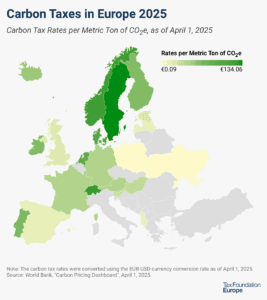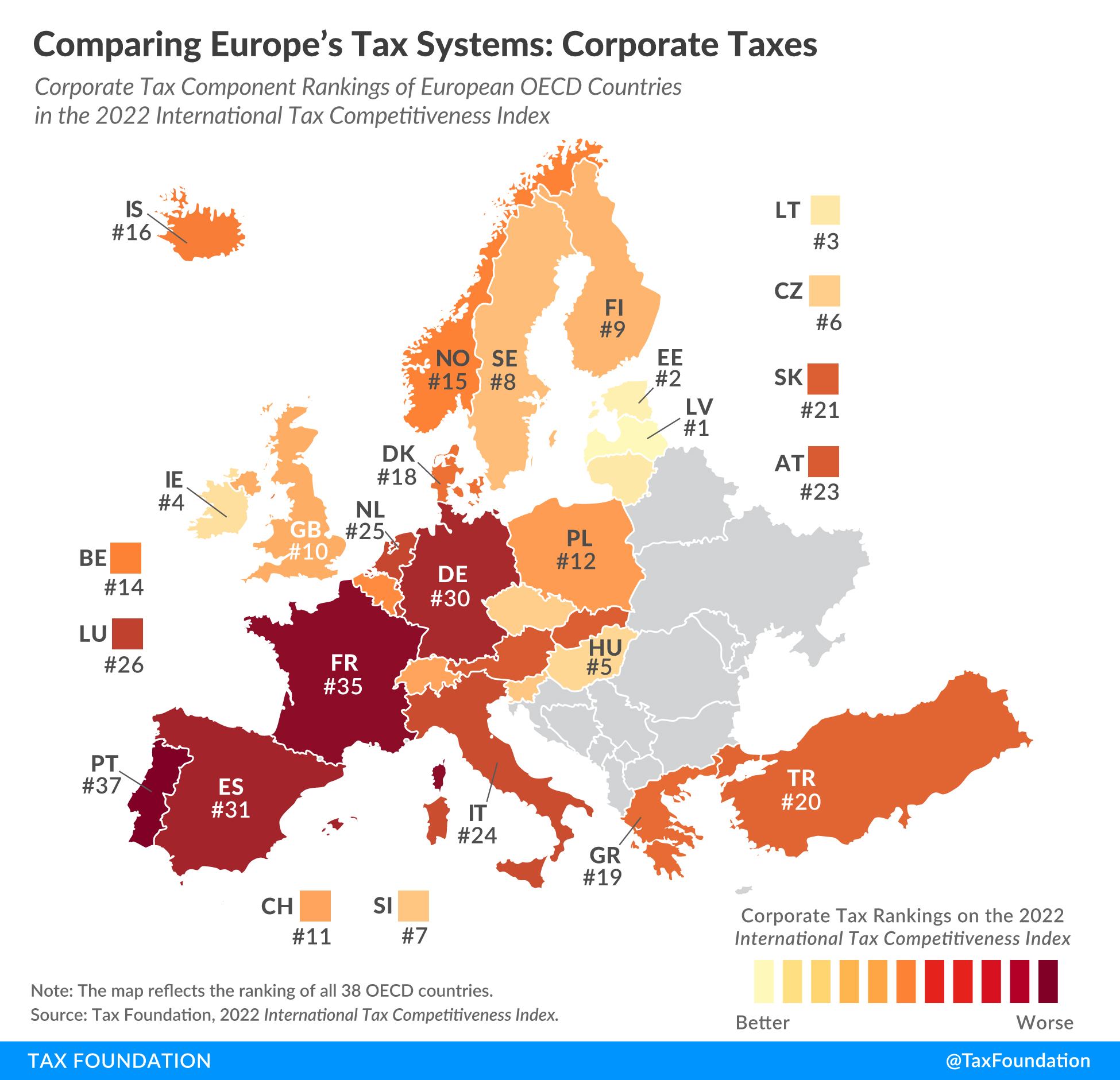
Comparing Europe’s Tax Systems: Corporate Taxes
3 min readBy:On October 17, we released the International Tax Competitiveness Index 2022, a study that measures and compares the competitiveness and neutrality of all 38 Organisation for Economic Co-operation and Development (OECD) countries’ tax systems. In the coming weeks, we will illustrate how European OECD countries rank in each of the five components of the Index: corporate income taxes, individual taxes, consumption taxes, property taxes, and the international taxA tax is a mandatory payment or charge collected by local, state, and national governments from individuals or businesses to cover the costs of general government services, goods, and activities. system.
Today, we look at how European countries’ corporate income tax systems compare within the OECD.
Unlike other studies that compare tax burdens, the Index measures how well a country structures its tax code. A competitive and neutral tax code promotes sustainable economic growth and investment while raising sufficient revenue for government priorities.
Our corporate income taxA corporate income tax (CIT) is levied by federal and state governments on business profits. Many companies are not subject to the CIT because they are taxed as pass-through businesses, with income reportable under the individual income tax. component scores countries not only on their corporate tax rates but also on how they handle net operating losses, capital allowances, inventory valuation, and allowances for corporate equity. We also consider whether and to what extent distortionary patent boxes and R&D tax incentives are granted, the application of digital services taxes, and the complexity of the corporate income tax.
Learn more about your country’s rankings on the 2022 International Tax Competitiveness Index here.
Latvia and Estonia have the best corporate tax systems in the OECD. Both countries have a cash-flow tax on business profits, meaning that profits only get taxed when they are distributed to shareholders. If a business decides to reinvest its profits instead of paying dividends to shareholders, there is no tax on such profits.
In contrast, Portugal has the least competitive and neutral corporate income tax system in Europe (Colombia ranks the lowest in the OECD). At 31.5 percent, Portugal levies one of the highest corporate tax rates on business profits. Only limited net operating losses can be carried forward and carried back, and purchases of machinery, buildings, and intangibles cannot be fully expensed.
To see whether your country’s corporate tax rank has improved in recent years, check out the table below. To learn more about how we determined these rankings, read our full methodology here.
| Corporate Tax Component of the International Tax Competitiveness Index between 2020 and 2022 (for all OECD countries) | ||||
|---|---|---|---|---|
| OECD Country | 2020 Rank | 2021 Rank | 2022 Rank | Change from 2021 to 2022 |
| Australia (AU) | 30 | 28 | 29 | 1 |
| Austria (AT) | 25 | 22 | 23 | -1 |
| Belgium (BE) | 11 | 12 | 14 | -2 |
| Canada (CA) | 24 | 26 | 27 | -2 |
| Chile (CL) | 35 | 20 | 13 | 7 |
| Colombia (CO) | 36 | 35 | 38 | -3 |
| Costa Rica (CR) | 34 | 36 | 36 | 0 |
| Czech Republic (CZ) | 6 | 6 | 6 | 0 |
| Denmark (DK) | 10 | 17 | 18 | -1 |
| Estonia (EE) | 2 | 2 | 2 | 0 |
| Finland (FI) | 9 | 9 | 9 | 0 |
| France (FR) | 38 | 37 | 35 | 2 |
| Germany (DE) | 29 | 30 | 30 | 0 |
| Greece (GR) | 20 | 16 | 19 | -3 |
| Hungary (HU) | 5 | 5 | 5 | 0 |
| Iceland (IS) | 13 | 15 | 16 | -1 |
| Ireland (IE) | 4 | 4 | 4 | 0 |
| Israel (IL) | 16 | 13 | 17 | -1 |
| Italy (IT) | 27 | 27 | 24 | 3 |
| Japan (JP) | 32 | 32 | 33 | -1 |
| Korea (KR) | 33 | 34 | 34 | 0 |
| Latvia (LV) | 1 | 1 | 1 | 0 |
| Lithuania (LT) | 3 | 3 | 3 | 0 |
| Luxembourg (LU) | 22 | 25 | 26 | -1 |
| Mexico (MX) | 28 | 29 | 28 | 1 |
| Netherlands (NL) | 23 | 24 | 25 | -1 |
| New Zealand (NZ) | 31 | 33 | 32 | 1 |
| Norway (NO) | 15 | 14 | 15 | -1 |
| Poland (PL) | 12 | 11 | 12 | -1 |
| Portugal (PT) | 37 | 38 | 37 | 1 |
| Slovak Republic (SK) | 18 | 19 | 21 | -2 |
| Slovenia (SI) | 7 | 7 | 7 | 0 |
| Spain (ES) | 26 | 31 | 31 | 0 |
| Sweden (SE) | 8 | 8 | 8 | 0 |
| Switzerland (CH) | 14 | 10 | 11 | -1 |
| Turkey (TR) | 17 | 23 | 20 | 3 |
| United Kingdom (GB) | 21 | 18 | 10 | 8 |
| United States (US) | 19 | 21 | 22 | -1 |
| Source: International Tax Competitiveness Index 2022. | ||||






